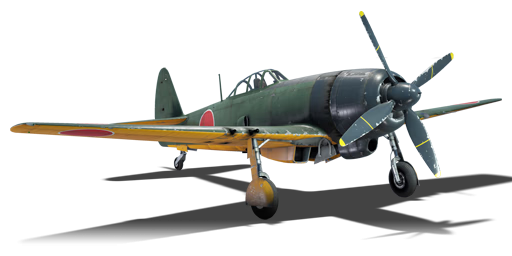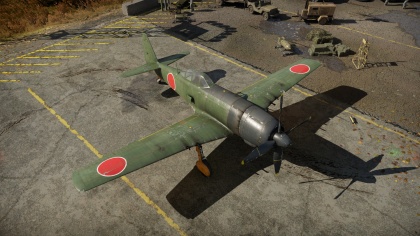Ki-94-II
Contents
Description
The Ki-94-II is a gift Rank IV Japanese fighter
with a battle rating of 5.7 (AB/SB) and 6.0 (RB). It was introduced during Update 1.69 "Regia Aeronautica" in the "Operation S.U.M.M.E.R." event of 2017 after earning 13 pilot Marks of Distinction.
The Tachikawa Ki-94-II should be used as a Boom & Zoomer and a Boom & Runner depending on the situation. The Ki-94-II should be above all enemy aircraft in order to Boom & Zoom. When used as a Boom & Zoomer, set the throttle to 20%-50%. The reason behind that is the Ki-94-II's engine response to throttle change from 0% to 100% or WEP is poor, it takes 5 seconds or more for the engine to go back to full power which can be a cause of death if you're trying to climbing back to altitude without engine power. If you meet players at your height, that's when Boom & Run comes into place. After going head-on with them (if you do), do not turn back to them. Level your plane out and keep flying straight to gain speed and keep doing that until the enemy pilot turns away. After that, climb more then resume Boom & Zoom.
General info
Flight Performance
Describe how the aircraft behaves in the air. Speed, manoeuvrability, acceleration and allowable loads - these are the most important characteristics of the vehicle.
| Characteristics | |||||||
|---|---|---|---|---|---|---|---|
| Stock | |||||||
| Max Speed (km/h at 12,000 m) |
Max altitude (meters) |
Turn time (seconds) |
Rate of climb (meters/second) |
Take-off run (meters) | |||
| AB | RB | AB | RB | AB | RB | ||
| 687 | 673 | 14000 | 24.6 | 25.1 | 11.6 | 13.5 | 600 |
| Upgraded | |||||||
| Max Speed (km/h at 12,000 m) |
Max altitude (meters) | Turn time (seconds) | Rate of climb (meters/second) |
Take-off run (meters) | |||
| AB | RB | AB | RB | AB | RB | ||
| ? | 720 | 14000 | ??.? | 23.0 | ??.? | 17.0 | 600 |
Details
| Features | ||||
|---|---|---|---|---|
| Combat flap | Take-off flap | Landing flap | Air brakes | Arrestor gear |
| ✓ | ✓ | ✓ | X | X |
| Limits | ||||
|---|---|---|---|---|
| Wing-break speed (km/h) |
Gear limit (km/h) |
Combat flap (km/h) |
Max Static G | |
| + | - | |||
| 850 | 280 | ??? | ~?? | ~? |
| Optimal velocities | |||
|---|---|---|---|
| Ailerons (km/h) |
Rudder (km/h) |
Elevators (km/h) |
Radiator (km/h) |
| < ??? | < ??? | < ??? | > ??? |
| Compressor (RB/SB) | ||
|---|---|---|
| Setting 1 | ||
| Optimal altitude | 100% Engine power | WEP Engine power |
| ?,??? m | ??? hp | ?,??? hp |
Survivability and armour
- 70 mm Bulletproof glass - Armored windscreen
- 8.5 mm Steel plate in the nose
Armaments
Offensive armament
The Ki-94-II is armed with:
- 2 x 30 mm Ho-155 cannon, wing-mounted (100 rpg = 200 total)
- 2 x 20 mm Ho-5 cannon, wing-mounted (200 rpg = 400 total)
Suspended armament
The Ki-94-II can be outfitted with the following ordnance:
- Without load
- 2 x 50 kg Army Type 94 GPHE bombs (100 kg total)
- 2 x 250 kg Army Type 92 GPHE bombs (500 kg total)
Usage in battles
The Ki-94-II has a powerful engine, producing up to 2,440 hp in-game. It has long wings which resemble the ones of the Ta 152. The Ki-94-II's elevator is very responsive at 500-700 kph which is impressive for a prop aircraft. However, the climb rate of the Ki-94-II is abysmal without modifications. With all modifications, it can climb with P-47s. The Ki-94-II is a durable plane, it can take quite a few hits to its airframe without dying immediately. However, the fuel tanks are not well-protected, so expect them to get lit on fire fairly easily.
The Ki-94-II's main role is bomber intercepting but it can also be used as a fighter. As said earlier, the Ki-94-II should climb above all enemies by side-climbing to Boom & Zoom. Boom & Run is used if you and another enemy are at the same altitude, level the plane out and keep flying straight until the enemy turns away. Stick to your teammates in case you need help.
Spitfires are your worse enemy. They climb and turn better. P-47s can be problematic, but the Ki-94-II can out-turn them with proper use of flaps, elevator keys and throttle control. P-51Ds can also be an issue of the pilots behind them know what they're doing. Bombers such as the B-17, the B-24 and the B-29 are not much of a threat as the Ki-94-II's main role is to intercept them, however look out for their gunners as they can be deadly.
Manual Engine Control
| MEC elements | ||||||
|---|---|---|---|---|---|---|
| Mixer | Pitch | Radiator | Supercharger | Turbocharger | ||
| Oil | Water | Type | ||||
| Controllable | Not controllable | Not controllable | Not controllable | Separate | Not controllable | Not controllable |
Modules
| Tier | Flight performance | Survivability | Weaponry | ||
|---|---|---|---|---|---|
| I | Fuselage Repair | Radiator | |||
| II | Compressor | Airframe | |||
| III | Wings Repair | Engine | |||
| IV | Engine Injection | Cover | |||
Pros and cons
Pros:
- Very good firepower
- Good roll rate
- Impressive elevator response at 500-700 kph
- High red-line speed of over 800 kph
- Quite good at turning at high speeds
- Climb-rate becomes okay with performance modules
- Flaps, throttle control and elevator keyboard keys help it turn better than most American planes and Yaks (heavily dependent on the pilot behind the plane!)
- Strong and effective flaps
Cons:
- Bad climb-rate when the plane is stock
- Default belts for the 20 mms and 30 mms are not good
- Engine response to throttle is poor; takes approximately 5 or more seconds for the engine to go back to full power after setting it from 0% to 100% or WEP
- Mediocre acceleration
- The Spitfire is its worse enemy
- Slow at low altitudes where most fights take place
- Low top speed at sea level compared to the sea level top speeds of the planes it faces
History
The Ki-94-II was Tachikawa Aircraft Company Ltd's response to the Japanese Imperial Army Air Force demands for a fast, high altitude interceptor featuring heavy armament as soon as Japanese intelligence learned about the B-29 to counter the B-29 raids as the aircraft available at that time for the IJAAF were inadequate to combat B-29s. The Ki-94-II was developed from the original Ki-94; the Ki-94-I which was an experimental high altitude interceptor with 2 propellers and a twin-tailed boom configuration (such as the tail of the Venom and the Vampire), one was a normal propeller on the front and the other was a pusher prop on the back. The Ki-94-II was created by Tatsuo Hasegawa. There were 2 prototypes of the Ki-94-II, one was fitted with a 4-blade propeller and the other one was to be fitted with a 6-blade propeller however the war ended before any of the prototypes made their maiden flight so the project was cancelled. The aircraft had 2 x 20 mm Ho-5 cannons and 2 x 30 mm Ho-155-I cannons, 150 rpg per 20 mm and 30 mm, 600 rounds in total.
Media
Excellent additions to the article would be video guides, screenshots from the game, and photos.
See also
Links to the articles on the War Thunder Wiki that you think will be useful for the reader, for example:
- reference to the series of the aircraft;
- links to approximate analogues of other nations and research trees.
External links
| Japan fighters | |
|---|---|
| Navy | |
| Carrier-based fighter | |
| A5M | A5M4 · Hagiri's A5M4 |
| A6M | A6M2 mod. 11 · A6M2 · A6M3 · A6M3 mod. 22 · A6M3 mod. 22Ko · A6M5 · A6M5 Ko · A6M5 otsu · A6M5 Hei · A6M6c |
| A7He | A7He1* |
| A7M | A7M1 (NK9H) · A7M2 |
| Land-based Fighter | |
| J2M | J2M2 · J2M3 · J2M4 Kai · J2M5 · J2M5 (30 mm) |
| J6K | J6K1 |
| J7W | J7W1 |
| N1K-J | N1K1-Ja · N1K2-J · N1K2-Ja |
| Fighter seaplane | |
| N1K | N1K1 |
| A6M-N | A6M2-N |
| Army | |
| Ki-10 | Ki-10-I · Ki-10-I C · Ki-10-II · Ki-10-II C |
| Ki-27 | Ki-27 otsu · Ki-27 otsu Tachiarai |
| Ki-43 | Ki-43-I · Ki-43-II · Ki-43-III otsu |
| Ki-44 | Ki-44-I · Ki-44-I 34 · Ki-44-II otsu · Ki-44-II hei |
| Ki-61 | Ki-61-I ko · Ki-61-I otsu · Ki-61-I hei · Tada's Ki-61-I hei · Ki-61-I tei · Ki-61-II Otsu Kai |
| Ki-84 | Ki-84 ko · Ki-84 otsu · Ki-84 hei |
| Ki-87 | Ki-87 |
| Ki-94 | Ki-94-II |
| Ki-100 | Ki-100 · Ki-100-II |
| Other countries | ▅F4U-1A · ▅P-51C-11-NT · ▅Bf 109 E-7 · ▅Fw 190 A-5 |
| *Imported designation of the He 112 (A6M was in development - A7M would take A7 designation after the cancelation of the A7He) | |





